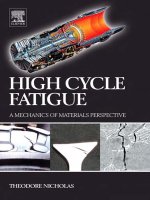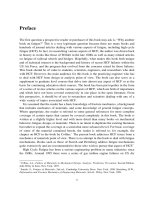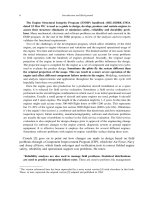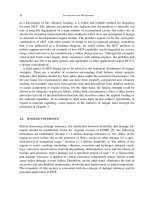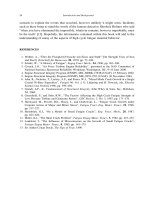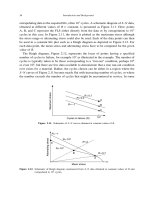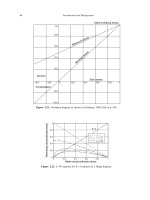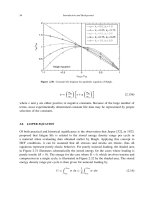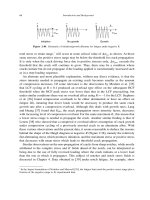High Cycle Fatigue: A Mechanics of Materials Perspective part 34 pot
Bạn đang xem bản rút gọn của tài liệu. Xem và tải ngay bản đầy đủ của tài liệu tại đây (253.6 KB, 10 trang )
316 Effects of Damage on HCF Properties
P
Q
–b –a a b
Figure 6.53. Contact geometry for flat pad with radius. b is the semi-width of the overall contact and a is the
semi-width of the central flat part.
0.3
0.5
0.4
0.2
0.1
0
0 0.1 0.2 0.3 0.4 0.5 0.6 0.7 0.8 0.9 1
0.6
0.7
0.8
0.9
1
Q
/P = 0.1
Q
/P = 0.3
Q
/P = 0.5
Q
/P = 0.7
Q
/P = 0.9
Slip zone friction coefficient, f
n
Hertzian case, a /b = 0
Almost sharp punch, a
/b = 0.99
Mean friction coefficient, f
m
Figure 6.54. Numerical results for different contact geometrics, a/b =002 045 07 09 0 99 [65].
These numerical findings are consistent with those of the previously cited references
where larger local values of COF are deduced from combined experimental and numerical
findings. These higher values are known to affect the local contact stresses which, in turn,
can have a significant impact on crack initiation criteria and a lesser impact on crack
growth behavior away from the local contact stress field. Thus, the value of COF becomes
an important aspect in the analysis of fretting-fatigue conditions and, unfortunately, is
not an experimentally measurable quantity.
Fretting Fatigue 317
6.14.1. Average versus local coefficient of friction
The average COF, , is commonly obtained experimentally by increasing the shear load
in a contact region until the bodies in contact just start to slide with respect to each
other. Of greater importance, however, for modeling purposes, is the local value of m in
the slip region in stick–slip contacts. The average value and local slip zone value have
been shown to be different. The slip zone coefficient of friction,
s
, is obtained from the
average value as follows [27]
s
=+
2
s
0
B
√
1−B +sin
−1
√
1−Bd
s
(6.31)
where B = Q/
s
P
0
is the initial value of COF, and is the average value. Equa-
tion (6.31) ignores the effect of the bulk load on the contact tractions and assumes that
the friction coefficient in the stick zone does not change.
Araújo and Nowell [43] later reported a change in the equation due to a slight error that
they describe as affecting the final form of the equation but the values are little changed.
The revised equation has the form
s
=+
4Q
P
2
−cot
s
−
s
−
2
s
s
−
Q
P
tan
s
(6.32)
where
s
=sin
−1
Q
s
P
s
=cos
−1
Q
s
P
(6.33)
6.15. SUMMARY COMMENTS
Three main factors have to be addressed in a robust life prediction scheme for fretting
fatigue:
1. The initiation life has to be treated separately from the propagation life. While no
definition can be given for the flaw size that separates initiation from propagation,
many instances arise where the crack propagation results are insensitive to the actual
value used. The use of the value of a
0
from the El Haddad short crack formulation
appears to be a reasonable approach, but a
0
takes on different values depending on
stress ratio, R, in many cases. It is also somewhat dependent on the geometry of the
body into which the crack propagates, but generally only for long cracks.
2. Point stresses in the presence of steep stress gradients cannot be used as part of
a realistic criterion for crack initiation. Instead, they must be modified as in notch
318 Effects of Damage on HCF Properties
fatigue in order to be able to consolidate them with smooth bar fatigue data. In
fretting fatigue we are normally dealing with stress fields that are the equivalent of
those encountered at the tip of a very sharp notch. Multiaxial stress states can be an
important consideration when establishing initiation criteria.
3. The stresses necessary to initiate a crack in fretting fatigue in the contact region may
be altered by the presence of damage from the fretting process itself, by changes
in COF, , by changes in the surface roughness, or through local plasticity and/or
material removal at the surface. These considerations should be taken into account
in model development.
In all of the above, the application to HCF as opposed to LCF can be addressed in some
cases by treating the problem as one where the threshold for crack propagation is the
governing criterion, whether or not a real crack has initiated. In such cases, it would have
to be shown whether or not an initiated fretting-fatigue crack would continue to propagate
based on the combination of a local stress field from the contact conditions and a far-field
stress field from the loaded component into which the crack is propagating.
There have been many successes using fracture-mechanics-based criteria for HCF
thresholds (and LCF lives) in fretting fatigue based on the use of a friction coefficient
that is appropriate for the particular experimental configuration. For HCF thresholds, it
is assumed, further, that the threshold crack growth value in a gradient stress field is the
same as that obtained under uniform stress (see Chapter 8 for a discussion of factors that
affect crack growth threshold values).
For an extensive coverage of fretting fatigue including background, experiments and
experimental results, and analytical methods including life prediction, the reader is referred
to the review article by Farris et al. [66].
REFERENCES
1. Vingsbo, O. and Söderberg, D., “On Fretting Maps”, Wear, 126, 1988, pp. 131–147.
2. Hutson, A.L., Nicholas, T., and Goodman, R., “Fretting Fatigue of Ti-6Al-4V Under Flat-on-Flat
Contact”, Int. J. Fatigue, 21, 1999, pp. 663–669.
3. Araújo, J.A. and Nowell, D., “Analysis of Pad Size Effects in Fretting Fatigue Using Short
Crack Arrest Methodologies”, Int. J. Fatigue, 21, 1999, pp. 947–956.
4. Tomlinson, G.A., Thorpe, P.L., and Gough, H.J., “An Investigation of the Fretting Corrosion of
Closely Fitting Surfaces”, Proc. Inst. Mech. Engrs, London, 141, 1939, pp. 223–237.
5. Conner, B.P. and Nicholas, T., “Using a Dovetail Fixture to Study Fretting Fatigue and Fretting
Palliatives”, ASME Jour. Eng. Mat. Tech., 128, 2006, pp.133–141.
6. Gean, M.C., “Finite Element Analysis of the Mechanics of Blade Disk Contacts”, M.S. Thesis,
School of Aeronautics and Astronautics, Purdue University, West Lafayette, IN, May 2004.
7. Golden, P.J. and Nicholas, T., “The Effect of Angle on Dovetail Fretting Experiments in Ti-
6Al-4V”, Fatigue Fract. Engng Mater. Struct., 28, 2005, pp.1169–1175.
Fretting Fatigue 319
8. Hutson, A.L., Nicholas, T., Olson, S.E., and Ashbaugh, N. E. “Effect of Sample Thickness
on Local Contact Behavior in a Flat-on-Flat Fretting Fatigue Apparatus”, Int. J. Fatigue, 23,
2001, pp. S445–S453.
9. Tada, H., Paris, P.C., and Irwin, G.R., Stress Analysis of Cracks Handbook, Del Research
Corp., Hellertown, PA, 1973.
10. Eden, E.M., Rose, W.N., and Cunningham, F.L., “The Endurance of Metals – Experiments on
Rotating Beams at University College”, Proc. Inst. Mech. Engrs., London, 4, 1911, pp. 839–974.
11. Tomlinson, G.A., “The Rusting of Steel Surfaces in Contact”, Proc. Roy. Society (London),
A115, 1927, pp. 472–483.
12. Forrest, P.G., Fatigue of Metals, Pergamon Press, Oxford, 1962 (U.S.A. Edition distributed by
Addison-Wesley Publishing Co., Reading, MA).
13. Poon, C. and Hoeppner, D.W., “The Effect of Environment on the Mechanism of Fretting
Fatigue”, Wear, 52, 1979, pp. 175–191.
14. Schütz, W., “A History of Fatigue”, Engng Fract. Mech., 54, 1996, pp. 263–300.
15. Giannakopoulos, A.E., Venkatesh, T.A., Lindley, T.C., and Suresh, S., "The Role of Adhesion
in Contact Fatigue”, Acta Materialia, 47, 1999, pp. 4653–4664.
16. Taylor, D.E., “Environmental Fretting Fatigue”, Fretting Fatigue, ESIS 18, R.B. Waterhouse
and T.C. Lindley, eds, Mechanical Engineering Publications, London, 1994, pp. 375–389.
17. Conner, B.P., Hutson, A.L., and Chambon, L., “Observations of Fretting Fatigue Micro-Damage
of Ti-6Al-4V”, Wear, 255, 2003, pp. 259–268.
18. Faanes, S. and Fernando, U.S., “Life Prediction in Fretting Fatigue using Fracture Mechanics”,
Fretting Fatigue, ESIS 18, R.B. Waterhouse and T.C. Lindley, eds, Mechanical Engineering
Publications, London, 1994, pp. 149–159.
19. Waterhouse, R.B., “Fretting Fatigue”, Int. Mater. Rev., 37, 1992, pp. 77–97.
20. Hills, D.A., Nowell, D., and O’Connor, J.J., “On the Mechanics of Fretting Fatigue”, Wear,
125, 1988, pp. 129–146.
21. Szolwinski, M. and Farris, T., “Mechanics of Fretting Fatigue Crack Formation”, Wear, 198,
1996, pp. 93–107.
22. Golden, P.J. and Grandt, A.F. Jr., “Fracture Mechanics Based Fretting Fatigue Life Predictions
in Ti-6Al-4V”, Eng. Fract. Mech., 71, 2004, pp. 2229–2243.
23. Mutoh, Y. and Xu, J Q., “Fracture Mechanics Approach to Fretting Fatigue and Problems to
be Solved”, Tribology International, 36, 2003, pp. 99–107.
24. Hills, D.A., Nowell, D., and Sackfield, A., Mechanics of Elastic Contacts, Butterworth-
Heinemann, Oxford, 1993.
25. Mindlin, R.D., “Compliance of Elastic Bodies in Contact”, ASME J. Appl. Mech., 16, 1949,
pp. 259–268.
26. Golden, P.J. and Calcaterra, J.R., “A Fracture Mechanics Life Prediction Methodology Applied
to Dovetail Fretting”, to be published in Tribology Int. Lyon presentation.
27. Hills, D.A. and Nowell, D., Mechanics of Fretting Fatigue, Kluwer Academic Publishers,
Dordrecht, The Netherlands, 1994.
28. Dobromirski, J.M., “Variables of Fretting Processes: Are There 50 of Them?”, Fretting Fatigue,
ESIS 18, R.B. Waterhouse and T.C. Lindley, eds, Mechanical Engineering Publications, Lon-
don, 1994, pp. 60–66.
29. Hutson, A.L., Neslen, C., and Nicholas, T., “Characterization of Fretting Fatigue Crack Initia-
tion Processes in Ti-6Al-4V”, Tribology International, 36, 2003, pp 133–143.
30. Ciavarella, M., Hills, D.A., and Monno, G., “The Influence of Rounded Edges on Indentation
by a Flat Punch”, Proc. Inst. Mech. Engrs., J. Mech. Eng. Sci., 212C, 1998, pp. 319–328.
320 Effects of Damage on HCF Properties
31. Giannakopoulos, A.E., Lindley, T.C., Suresh, S., and Chenut, C., "Similarities of Stress Con-
centrations in Contact at Round Punches and Fatigue at Notches: Implications to Fretting
Fatigue Crack Initiation”, Fatigue Fract. Eng. Mater. Struct, 23, 2000, pp. 562–571.
32. Johnson, K.L., Contact Mechanics, Cambridge University Press, Cambridge, 1985.
33. Murthy, H., Farris, T.N., and Slavik, D.C., “Fretting Fatigue of Ti-6A1-4V Subjected to
Blade/Disk Contact Loading”, Developments in Fracture Mechanics for the New Century50th
Anniversary of Japan Society of Materials Science, Osaka, Japan, May 2001, pp. 41–48.
34. McVeigh, P.A., Harish, G., Farris, T.N., and Szolwinski, M.P., “Modeling Contact Conditions
in Nominally Flat Contacts for Application to Fretting Fatigue of Turbine Engine Components”,
Int. J. Fatigue, 21, 1999, pp. S157–S165.
35. Lindley, T.C., “Fretting Fatigue in Engineering Alloys”, Int. J. Fatigue, 19, Supp. No. 1, 1997,
pp. S-39–S49.
36. Ruiz, C., Boddington, P.H.B., and Chen, K.C., “An Investigation of Fatigue and Fretting in a
Dovetail Joint”, Expt. Mechanics, 24, 1984, pp. 208–217.
37. Magaziner, R., Jin, O., and Mall, S., “Slip Regime Explanation of Observed Size Effects in
Fretting”, Wear, 257, 2004, pp. 190–197.
38. Naboulsi, S. and Mall, S., “Fretting Fatigue Crack Initiation Behavior Using Process Volume
Approach and Finite Element Analysis”, Tribology International, 36, 2003, pp. 121–131.
39. Lykins, C.D., Mall, S., and Jain, V.K., “A Shear Stress-Based Parameter for Fretting Fatigue
Crack Initiation”, Fatigue Fract. Eng. Mater. Struct., 24, 2001, pp. 461–473.
40. Findley, W.N., “Fatigue of Metals Under Combinations of Stresses”, Trans. ASME, 79, 1957,
pp. 1337–1348.
41. Namjoshi, S., Mall, S., Jain, V., and Jin, O., “Fretting Fatigue Crack Initiation Mechanism in
Ti-6Al-4V”, Fatigue Fract. Eng. Mater. Struct., 25, 2002, pp. 955–964.
42. Neu, R., Pape, J., and Swalla, D.R., “Methodologies for Linking Nucleation and Propagation
Approaches for Predicting Life Under Fretting Fatigue”, Fretting Fatigue; Current Technology
and Practices, ASTM STP 1367, D.W. Hoeppner, V. Chandrasekaran, and C.B. Elliot, eds,
American Society for Testing and Materials, West Conshohocken, PA, 2000, pp. 369–388.
43. Araújo, J.A. and Nowell, D., “The Effect of Rapidly Varying Contact Stress Fields on Fretting
Fatigue”, Int. J. Fatigue, 24, 2002, pp. 763–775.
44. Fatemi, A. and Socie, D.F., “A Critical Plane Approach to Multiaxial Fatigue Damage Including
Out of Phase Loading”, Fatigue Fract. Eng. Mater. Struct, 11, 1988, pp. 149–165.
45. Nowell, D. and Dini, D., “Stress Gradient Effects in Fretting Fatigue”, Tribology International,
36, 2003, pp. 71–78.
46. Nix, K.J. and Lindley, T.C., “The Application of Fracture Mechanics to Fretting Fatigue”,
Fatigue Fract. Eng. Mater. Struct., 8, 1985, pp. 143–160.
47. Nicholas, T., Hutson, A., John, R., and Olson, S., “A Fracture Mechanics Methodology Assess-
ment for Fretting Fatigue”, Int. J. Fatigue, 25, 2003, pp. 1069–1077.
48. Naboulsi, S. and Nicholas, T., “Limitations of the Coulomb Friction Assumption in Fretting
Fatigue Analysis”, Int. J. Solids Struct., 40, 2003, pp. 6497–6512.
49. Chan, K.S., Davidson, D.L., Lee, Y-D., and Hudak, S.J., Jr., “A Fracture Mechanics Approach
to High Cycle Fretting Fatigue Based on The Worst Case Fret Concept: Part I – Model
Development”, Int. J. Fract., 112, 2001, pp. 299–330.
50. McVeigh, P.A. and Farris, T.N., “Analysis of Surface Stresses and Stress Intensity Factors
Present During Fretting Fatigue”, Proceedings of the 40
th
AIAA/ASME/ASCE/ASC Structures,
Structural Dynamics, and Materials Conf., vol. 2, St Louis, MO, April 1999, pp. 1188–1196
(CD-ROM). See also: McVeigh, P.A., “Analysis of Fretting Fatigue in Aircraft Structures:
Fretting Fatigue 321
Stresses, Stress Intensity Factors, and Life Predictions”, Ph.D. Thesis, School of Aeronautics
and Astronautics, Purdue University, West Lafayette, IN, 1999.
51. Beghini, M., Bertini, L., and Fontanari, V., “Weight Function for an Inclined Edge Crack in a
Semi-plane", Int. J. Fract., 99, 1999, pp. 281–292.
52. Jin, O., Mall, S., and Sahan, O., “Fretting Fatigue Behavior of Ti-6Al-4V at Elevated Temper-
ature”, Int. J. Fatigue, 27, 2005, pp. 395–401.
53. Golden, P.J., Hutson, A.L., Bartha, B., and Nicholas, T., “A Comparison of Fretting Fatigue Test
Fixtures”, presented at ICEM 12 – 12th International Conference on Experimental Mechanics,
Bari, Italy, 29 August–2 September 2004. Conference proceedings only.
54. Jin, O. and Mall, S., “Effects of Independent Pad Displacement on Fretting Fatigue Behavior
of Ti-6Al-4V”, Wear, 253, 2002, pp. 585–596.
55. Naboulsi, S. and Mall, S., “Investigation of High Cycle and Low Cycle Fatigue Interaction on
Fretting Behavior”, Int. J. of Mechanical Sciences, 44, 2002, pp. 1625–1645.
56. McVeigh, P.A., Harish, G., Farris, T.N., and Szolwinski, M.P., “Modeling Contact Conditions
in Nominally Flat Contacts for Application to Fretting Fatigue of Turbine Engine Components”,
Int. J. Fatigue, 21, 1999, pp. S157–S165.
57. Swalla, D.R. and Neu, R.W., “Influence of Coefficient of Friction on Fretting Fatigue Crack
Nucleation Prediction”, Tribology International, 34, 2001, pp. 493–503.
58. Goh, C H., Wallace, J.M., Neu, R.W., and McDowell, D.L., “Polycrystal Plasticity Simulations
of Fretting Fatigue”, Int. J. Fatigue, 23, 2001, pp. S423–S435.
59. Farris, T.N., Murthy, H., and Matlik, J.F., “Fretting Fatigue”, Comprehensive Structural
Integrity Fracture of Materials from Nano to Macro; Volume 4: Cyclic Loading and
Fatigue, R.O. Ritchie and Y. Murakami, eds, Elsevier, 2003, pp 281–326.
60. Hutson, A.L., Niinomi, M., Nicholas, T., and Eylon, D., “Effect of Various Surface Conditions
on Fretting Fatigue Behaviour of Ti-6Al-4V”, Int. J. Fatigue, 24, 2002, pp. 1223–1234.
61. Namjoshi, S.A., Jain, V.K., and Mall, S., “Effects of Shot-Peening on Fretting Fatigue Behav-
ior of Ti-6Al-4V”, ASME Journal of Engineering Materials and Technology, 124, 2002,
pp. 222–228.
62. Nicholas, T., Hutson, A.L., Olson, S., and Ashbaugh, N., “In Search of a Parameter for
Fretting Fatigue”, Advances in Fracture Research, Proceedings of ICF-10, K. Ravi-Chandar,
B.L. Karihaloo, T. Kishi, R.O. Ritchie, A.T. Yokobori Jr., and T. Yokobori, eds, Paper # 0809,
CD ROM, Elsevier, 2001.
63. Hutson, A.L., John, R., and Nicholas, T., “Fretting Fatigue Crack Analysis in Ti-6Al-4V”, Int.
J. Fatigue, 27, No. 10–12 (Special Issue on Fatigue Damage of Structural Materials), 2005,
pp. 1582–1589.
64. Hills, D.A., Nowell, D., and Sackfield, A., “Surface Fatigue Consideration in Fretting”, Inter-
face Dynamics, Proceedings of the 14th Leeds-Lyon Symposium on Tribology, D. Dowson,
C.M. Taylor, M. Godet, and D. Berthe, eds, Elsevier, Amsterdam, 1988, pp. 35–50.
65. Dini, D. and Nowell, D, “Prediction of the Slip Zone Friction Coefficient in Flat and Rounded
Contact”, Wear, 254, 2003, pp. 364–369.
66. Farris, T.N., Murthy, H., and Matlik, J.F., “Fretting Fatigue”, Comprehensive Structural
Integrity Fracture of Materials from Nano to Macro; Volume 4: Cyclic Loading and Fatigue
R.O. Ritchie and Y. Murakami, eds, Elsevier, 2003, pp. 281–326.
Chapter 7
Foreign Object Damage
7.1. INTRODUCTION
Foreign object damage, commonly referred to as FOD, involves the damage caused by
objects ingested into turbine engines. These events typically take place upon takeoff and
landing. Ingested objects, which involve a range of soft and hard materials of all sizes
and shapes, cause damage when they strike rotating blades, static vanes, or other parts
of the engine where they cause a reduction in strength of the component. The damage is
typically in the form of a notch covering a wide range of notch depths, radii, and possible
cracking at the root of the notch. The problem is most severe when the extent of the
damage causes instantaneous failure of a component. Such events are difficult to prevent
although methods such as the use of screens have been unsuccessfully attempted at times
in the past. Debris on runways can be ingested into engines and is taken care of by routine
inspection of runways and taxiways and removal of such debris. Nonetheless, objects are
commonly ingested and can cause damage in the form of nicks, dents, tears, and so forth.
Damage, if not severe, can cause a reduction of the static strength of a component which
is handled in design by the use of some type of knockdown factor to account for FOD in
regions where such events are expected or known to take place from prior experience. A
greater concern arises when the component that is damaged is also undergoing some type
of forced or resonant vibration that can lead to HCF in the damaged area. The problem of
FOD is somewhat related to fatigue of notches, discussed in Chapter 5, but is much more
complicated because it involves additional aspects that are discussed later. The severity
of a notch, from a geometric point of view, is characterized by a stress concentration
factor, k
t
, which, under FOD, can vary significantly in service. Different types of damages
are illustrated later in this chapter as well as in Appendix G involving a wide variation
in geometry and corresponding values of k
t
. Robust engineering methods are needed to
predict the influence of these geometric variables on HCF threshold stresses.
It is the HCF failure and the HCF strength of damaged materials that is the main
subject of this chapter dealing with the HCF properties of materials and components that
are subjected to FOD. Both real and simulated FOD are discussed, the latter based on
the assumption that damage from an impacting object can be simulated by other impact
events. Low velocity and quasi-static impact events can produce damage that appears
to be geometrically similar to that obtained under ballistic impact. How representative
these events are in reproducing actual FOD is an important consideration in the study of
FOD. A further concern is the nature of the ingested object that causes the damage in
322
Foreign Object Damage 323
engines and is rarely identified in total after the event. Only the damaged component is
left behind to study the nature of FOD.
In turbine engines, FOD is caused most by the ingestion of birds, sand, dust, ice,
and other debris. This general problem is addressed by the US Department of Defense
through a specification guide that is applicable to all of the Services – Army, Navy,
Air Force, Marines, and Coast Guard. The specification guide, however, does not deal
with methods for designing against FOD or conducting analysis of damaged hardware.
Rather, it provides guidance for the testing of engines to qualify them for tolerance to
ingested objects of specified materials and sizes. Often, in the introduction of a new
engine, the objects that the engine may see in service are left up to the discretion of
the organization or service that builds the engine for specific applications and missions.
This highly empirical approach to FOD, detailed in a Joint Service Specification Guide
(JSSG), is summarized in Appendix H. Although the guide, in general, deals with the
types of debris noted above, it does not specifically deal with large sand particles or small
stones which have been found to be both common and very damaging to airfoils in gas
turbine engines. This type of debris will hereafter be referred to as hard particles. FOD
can also be caused by soft body impact such as due to birds. A common misconception
is that ice acts as a hard body impactor. Depending on temperature, ice can often appear
to display the characteristics of hard body impact, but the majority of time ice should be
thought of as a soft body impactor.
In addition to objects ingested into an engine that cause what we term FOD, there are
instances where the debris causing damage comes from an internal failure. For example,
tips of blades have been known to break off, usually due to some type of resonant
fatigue condition. Such an object can then proceed further down the engine and cause
impact damage on another component. Objects that are produced from internal failures
and subsequently impact some other engine component are considered to cause domestic
object damage (DOD). Although this section deals with the general subject of FOD, there
is no attempt to distinguish between FOD and DOD because both involve a dynamic
impact event. Thus, the terminology FOD will be used to describe all impact events
irrespective of the origin of the impacting object.
In this section, some observations and approaches to FOD from small hard objects are
presented. While no “standard” object for engine qualification exists, work is continuing
to define objects that might be impacted into blades that will cause the same level and
geometry of damage as is experienced in operational engines. For example, in one case,
a steel cube whose dimensions are approximately 3 mm on a side has been impacted
sideways against a blade and has been shown to cause damage that closely represents what
is seen in field hardware (see Appendix G). The damage, however, is specific to one engine
on one aircraft that performs certain missions and is probably not applicable to all blades in
all engines. In what follows, damage from a variety of sources, and methods for predicting
such damage and the resultant debit in HCF capability of a material, is discussed.
324 Effects of Damage on HCF Properties
The author is fortunate to have a contribution to this book in the form of Appendix G,
which supplements this section on FOD with detailed discussions of experimental simula-
tions of impact events, a discussion of the field events from which the impact conditions
were deduced, and details of analytical and numerical simulation methods. In this section,
we will concentrate on the nature of the FOD event and the resultant damage and relevant
parameters related to the damage and resulting debits to fatigue limit strength.
7.2. FIELD EXPERIENCE AND OBSERVATIONS
Foreign object damage is of great concern for both military and commercial engines. Field
experience has shown that FOD results in nicks and dents and reduces life expectancy
of those components exposed to vibratory loading. Most of the FOD experienced in the
field comes from sand ingestion with depths of about 0.076 mm (0.003") or less (see
Appendix G). Figure 7.1 illustrates engine blades with several types of FOD indicated by
the circles. Due to these types of events, supplementary FOD inspections and guidelines
(a)
(b)
(c)
(d)
Figure 7.1. In-service FOD: (a) 1st stage fan rotor blade; (b) compressor rotor blade; (c) close-up of (a);
(d) close-up of (b).
Foreign Object Damage 325
have been implemented into engine maintenance. The guidelines provide instructions on
serviceability and repair limits for damaged engine blades, which are based on the depth of
the damage. For numerous engines, field FOD inspection is conducted before and after each
flight by the maintenance crew chief, in order to prevent catastrophic in-flight failure [1].
Written requirements in the form of technical orders (TO) for both flight-line and
engine shop maintenance provide direction on the execution of the FOD inspection as
well as serviceability limits for each rotor blade and stator vane in the engine. Limits
for FOD found during a flight-line inspection are generally specified. The serviceability
limits determine whether the damage needs to be serviced or not. If the damage depth is
below the limit noted in the TO, it is recorded in the maintenance log. If the damage depth
exceeds the serviceability limit, it is then blended out by filing the blade. In addition, if
the damage depth exceeds the repairable limit, the engine is pulled out of the aircraft and
sent into the engine shop for replacement. If the FOD depth found on the 1st stage fan
rotor blade exceeds the serviceability limit, the 2nd and 3rd stage rotor blades must also
be inspected using a borescope.
As an example, the current serviceability limit for the first stage fan rotor blade on one
Air Force fighter engine is 0.76 mm (0.030"). If the damage depth exceeds the maximum
repairable limit of 3.8 mm (0.120"), the engine is pulled out of the aircraft for blade
replacement. In addition, the entire compressor section must be borescoped to determine
if there has been further engine FOD. Once blade replacement is accomplished, the engine
is thoroughly re-inspected before returning the engine to operation [1].
7.3. REPAIR BY BLENDING
There is no solid technical ground on which blend and repair limits have been established.
Rather, it is an experience-based approach that works well if the only stresses that a blade
sees are those due to centrifugal loading. The LCF stresses due to engine speed variations
and the corresponding cycle counts are all taken into account with adequate safety factors.
Two aspects of FOD and the resulting HCF capability are not well taken care of in a
blending operation. Little consideration is given to the possibility of a resonant vibration
occurring on the blended blade geometry, especially if the blended area becomes the
hot spot for the vibratory stresses. More important, possible damage may exist beyond
the depth of the nick that is blended out. In addition to the remaining damage, the area
beyond the blend may retain residual tensile stress from the FOD event. Characterization
of residual stress fields and microstructural damage from FOD events is certainly not a
mature technical area at this point in time. There have been instances where blending of
FOD indents has exposed a deeper region that contains residual tensile stresses. These
residual stresses, combined with centrifugal and vibratory stresses in the region, have led
to HCF failures in the “repaired” region.

